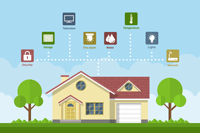Rather than admiring the Internet of Things (IoT) as a phenomenon, marketers should instead think of it as a unique bounty. That’s right, a marketer’s bounty of actionable opportunities.
Sounds enticing, doesn’t it? But paradoxically, for marketers, it’s not the IoT’s “Things” that make for the unprecedented opportunity; it’s the associated spending. Let’s discuss how IoT offers opportunities for marketers.
 The 20-to-30 billion Internet-facing devices expected worldwide by 2019 are but a carrier pigeon for the $1.3 billion in predicted IoT-related spending. What’s the third fastest IoT spending market? The consumer. Yes, that’s right, according to IT researcher IDC, more money will be spent on IoT-related consumer activities than any other market save insurance and healthcare—perhaps as much as hundreds of billions of dollars.
The 20-to-30 billion Internet-facing devices expected worldwide by 2019 are but a carrier pigeon for the $1.3 billion in predicted IoT-related spending. What’s the third fastest IoT spending market? The consumer. Yes, that’s right, according to IT researcher IDC, more money will be spent on IoT-related consumer activities than any other market save insurance and healthcare—perhaps as much as hundreds of billions of dollars.
While that amounts to just a bit more than a new smart refrigerator or two, for marketers, it presents opportunities for real-time engagement and service on new platforms and in new modalities.
Has there ever been a better confluence of technological, innovation and actionable marketing opportunity? Let’s go deeper into the details, where it gets really interesting:
Practical IoT Marketing
Here are three “practicals” to keep in mind for IoT-related marketing, with an understanding that not every connected asset is considered an IoT device. To qualify as IoT, a device must be equipped with unique identifiers, must have the ability to sense, automatically transfer data to a central repository based on a trigger or marker, and carry the promise to produce actionable insights.
1. Surfaces Smartphones, watches, performance trackers and “smart” appliances offer marketers new interaction points with customers. It’s important, however, to understand the constraints and opportunities of these emerging customer touch points—from design elements, color palettes and copy restrictions to display timing.
While not every new interface surface can be leveraged for ad displays, influencing a consumer’s experience is within a marketer’s control—subtle events such as push messaging, time-based marketing, brand identification and simple alerts—all are available options.
2. Communication Fundamentally, the IoT is about devices and people talking to one another. In that way, the technology enables new avenues of communication—between systems and appliances, systems/appliances to people, between people, and new ways for people to connect with each other.
An IoT communications ecosystem requires gearing together an unlimited number of non-integrated technologies. Leading IT companies such as Amazon and Apple have poured millions into developing platforms that enable consumers to talk back and forth with marketing touchpoints such as smart lights, appliances, locks, music and cookware.
It’s in the talking between people and devices where the messaging opportunities reside.
3. Search The interaction between people, devices and the Internet, along with the relative availability of data has catalyzed a tectonic shift in marketing opportunities. Because a new class of data will be available for marketers to examine macro effects and trends, search marketing, and particularly mobile, is evolving to use real-time intelligence to deliver immediate smart experiences to consumers.
The opportunity for marketers is in exploiting immediate, real-time data on the most effective media/channels to deliver the most-timely messaging.
Boiled down, the IoT enables marketers to consistently stay one-step ahead of consumers. That’s right—for marketers that’s what all the fuss is about, a way forward to deliver highly relevant messaging in real time. With that, of course, come some rules and considerations that are important to keep in mind.
A Shifting Experience Consumers already interact with technology differently than ever before. As an example, many consumers use smart pay apps, or mobile credit card processing to consummate their purchases. Mobile pay and other similar emerging technologies aren’t yet commonplace but just wait for the advances you’ll see in another year or two.
Staying abreast of consumers’ changing technology habits is an influencing factor to real-time, actionable marketing.
Transparency The enormous volume of data that the IoT will yield doesn’t come risk free.
Ease For marketers, the point and purpose of the IoT is to simplify consumers’ lives, something that’s obviously not going to occur overnight.
No matter the data, no matter the marketing campaign, the top-line goal is consumers going about their daily lives without unwanted interruption. Marketers that position their IoT-based marketing campaigns to support these goals and processes likely will find more lasting success.
Security Because the notion of networked appliances and other objects is relatively new, security largely isn’t baked into product design. For marketers, this can present some hesitancy for consumers to adopt new services or to welcome push marketing.
Security experts are warning consumers of the risks associated with open communications on all manner of smart devices. It’s a caution that IoT marketers should be aware of as well.
The road ahead
As the technology rapidly evolves, what we now consider to be the IoT will be relegated to the distant past in just a few years. Nevertheless, marketers who gain an understanding of practical IoT marketing will be better equipped to take advantage of future opportunities.
Curtis Thornhill is the founder/CEO of Apt Marketing Solutions. He can be reached at curtis@aptmarketinggroup.com



